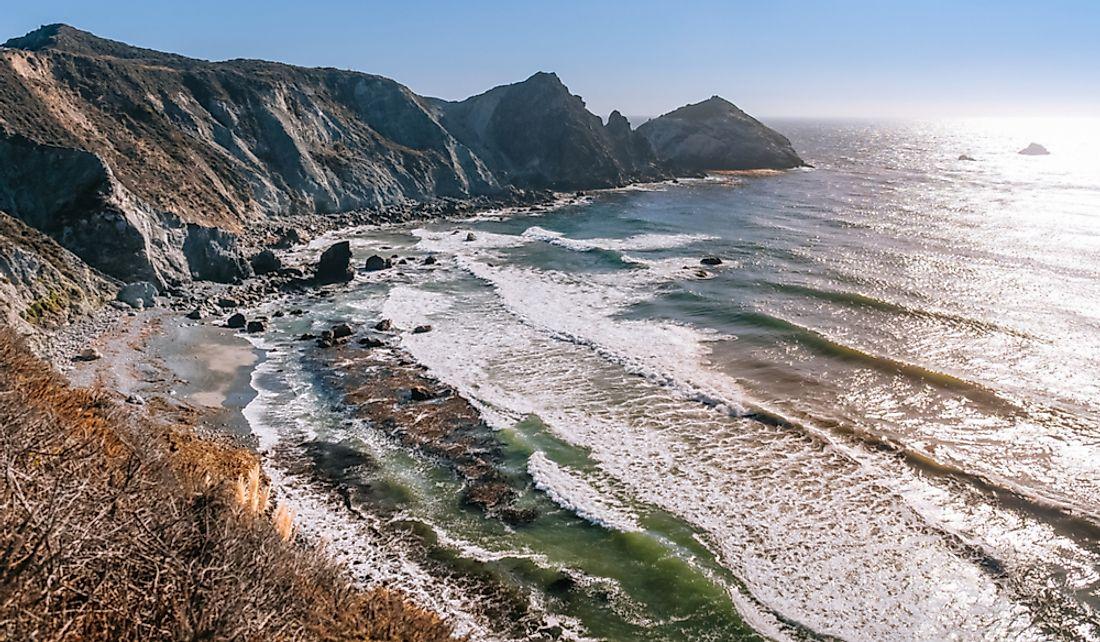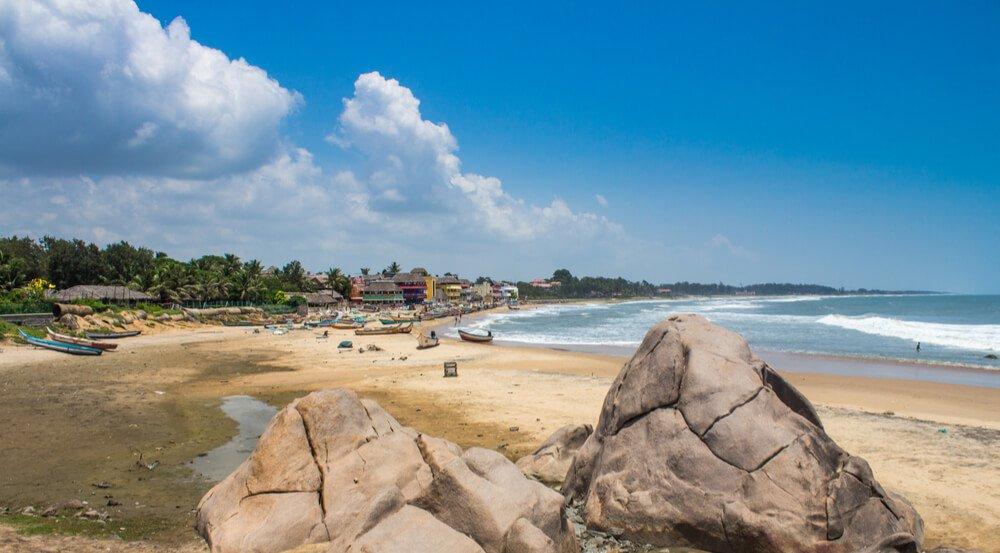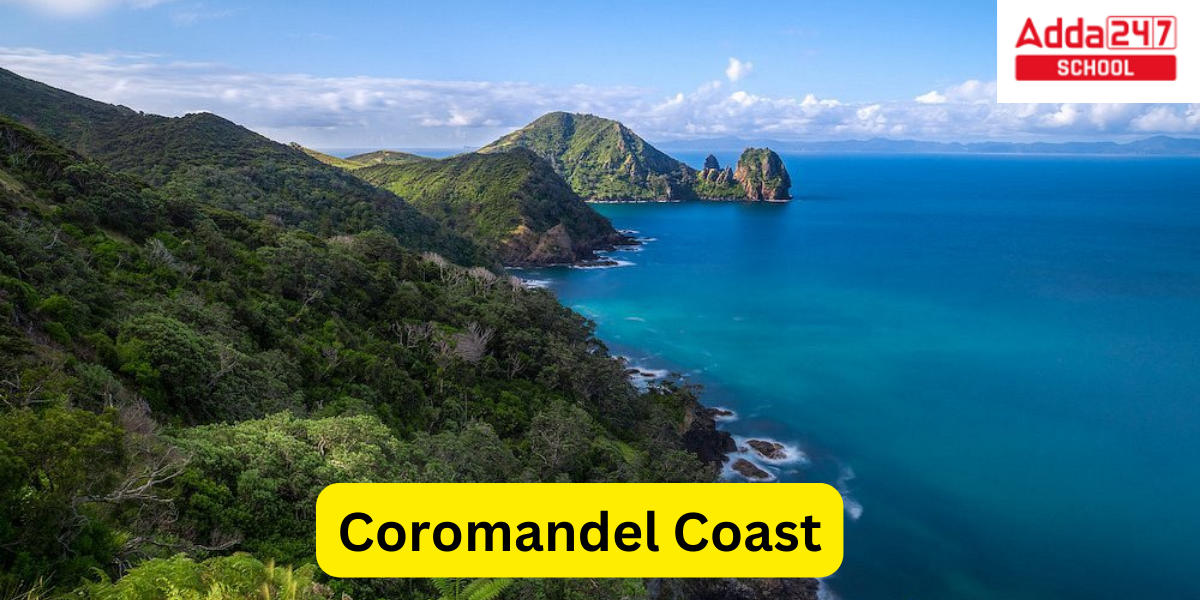Coromandel Coast
The Coromandel Coast, which covers an area of roughly 22,800 square kilometers and is located in the southeast of the Indian subcontinent, is bordered by the Utkal Plains to the north, the Bay of Bengal to the east, the Kaveri delta to the south, and the Eastern Ghats to the west.
The Eastern Ghats, a range of low-lying hills with flat tops, surround the coast, which is typically 80 metres above sea level. From the 12th century onward, the Coromandel Coast was referred to as Mabar in mediaeval Muslim literature.
Coromandel Coast in Which State
Coromandel Coast, a broad coastal plain in eastern Tamil Nadu state, of southern India. Coromandel Coast is Extending over an area of about 8,800 square miles (22,800 square km), Coromandel Coast is bounded by the Utkal Plains to the north, the Bay of Bengal to the east, the Kaveri Delta to the south, and the Eastern Ghats to the west.
Coromandel Coast: Geography and Map
- The Indian Plate, a significant tectonic plate that broke apart from Gondwanaland and began moving northward at a rate of around 15 cm per year during the late Cretaceous Period, has been moving northward for much of southern India’s geological history (about 90 million years ago).
- Its collision with the Eurasian mainland, which took place between 60 and 50 million years ago, is a continuing process that formed the Himalayan range and had an impact on the subcontinent’s physical and biological geography.
- According to data from fossil and modern fauna, India maintained trade relations with neighbouring countries throughout the late Cretaceous.
- There is no proof of an extended period of isolation before its interaction with Eurasia, for instance, in the history of endemic species.
- Hence, significant changes in physical topography, climatic zones, and species invasions are reflected in India’s ecosystem.
Coromandel Coast in India Map
Coromandel Coast: Flora
The East Deccan dry evergreen forests ecoregion, which occupies a small area of the Coromandel Coast, are found there. The East Deccan dry evergreen forests of India retain their leathery leaves all year round, in contrast to the majority of the other tropical dry forest Biome regions, when trees shed their leaves during the dry season.
Moreover, the Coromandel Coast is home to vast mangrove forests along the low-lying shore and river deltas, as well as a number of significant wetlands, including Kaliveli Lake and Pulicat Lake, which provide as habitat for numerous resident and migratory species.
Coromandel Coast: Evolution of Coastal Flora and Fauna
Wide variations in climate and geology over the modern Deccan Peninsula further diversify Southern India’s biodiversity. The Western Ghats, a region with a notable biodiversity hotspot, and the better-watered Malabar Coast are where you may find deciduous woods in the greatest abundance. The drier, central Deccan plateau is naturally home to more Deccan thorn scrub woods. Due in part to the unpredictable, seasonal nature of the monsoon and the fact that the Coromandel Coast is in the rain shadow of the Western Ghats mountain range, Chennai is one of the driest cities in the nation.
The Coromandel Coast receives about 1,250mm of rain annually, but there is a clear gradient from north to south and a highly seasonal pattern, with light rains from June to September and sporadic heavy falls between October and December, primarily brought on by depressions forming in the Bay of Bengal.
Coromandel Coast: History
- There were three Portuguese settlements on the Coromandel Coast by the end of 1530: Nagapattinam, Sao Tome de Meliapore, and Pulicat.
- The Coromandel Coast served as the backdrop for conflicts between European countries competing for control of the India trade in the 17th and 18th centuries.
- The Dutch established themselves at Pulicat, Sadras, and Covelong, the French in Pondicherry, Karaikal, and Nizampatnam, the British in Fort St. George (Madras) and Masulipatnam, and the Danish in Dansborg near Tharangambadi.
- The Thai monarchy and court of Siam received Indian Muslim eunuchs from the Coromandel Coast (modern Thailand).
- Because they held Chinese eunuchs in such high respect, the Thai occasionally requested that they visit the Thai court and offer them advice on court customs.
- Though France held onto the little outposts of Pondichery and Karaikal until 1954, the Brits ultimately prevailed.
- Due to the fact that many Chinese exports were consolidated at the Coromandel ports in the 18th century, Chinese lacquer items such as boxes, screens, and chests came to be known as “Coromandel” commodities.
- The World of the Weaver in Northern Coromandel, c.1750-c.1850 and Merchants, Companies, and Commerce on the Coromandel Coast, 1650-1740 by Arasaratnam, published by Oxford University Press in 1986, are two well-known volumes on the economic history of the Coromandel Coast.

Coromandel Coast: Origin of the Name
The Chola dynasty’s homeland was known in Tamil as Cholamandalam, which means The kingdom of the Cholas. The Portuguese used this term as the source for Coromandel. The phrase “reality of the Beaches” or “Kari mandalam” could also be used to denote the name.

The name “Karimandalam,” which refers to a settlement on the Sriharikota island in Pazhavercadu’s north, is pronounced “Coromondel” in Dutch (Pulecat Lake). The name Coromandel may have been coined by an Italian explorer named Ludovico di Varthema in 1510; it was afterwards used on maps by the Portuguese, but it was the Dutch who began to engage in major trade there.
Coromandel Coast: The Indian Ocean Earthquake
The Indian Ocean earthquake, one of the deadliest natural disasters in recent memory, occurred off the western coast of Sumatra on December 26, 2004. (Indonesia). Some 220,000 people are said to have perished near the Indian Ocean’s rim as a result of the earthquake and the ensuing tsunami. The tsunami wreaked havoc on the Coromandel Coast, claiming many lives and destroying numerous coastal settlements.
Coromandel Coast: Importance
The name HMS Coromandel was given to four Royal Navy vessels in honour of the Indian coastline. One of these ships served in the Coromandel Peninsula, which bears the same name as the town of Coromandel in New Zealand. The ship Coromandel, which brought 156 English settlers to Holdfast Bay from London in 1837, gave the South Australian suburbs of Coromandel Valley and Coromandel East their names. Several of the crew members absconded after the ship had reached the shore with the intention of staying behind in South Australia and sought safety in the hills of the Coromandel Valley area.
Coromandel Coast: Human Evolution
- Southeast India’s Coromandel Coast has a very long history of human habitation and land use alteration, which has significantly reduced the amount of native forest there.
- Although there is consensus that the habitat type is locally typical despite being substantially diminished, fragmented, and degraded, there are divergent opinions regarding the precise characteristics of native tropical dry evergreen forest (TDEF).
- To ascertain the properties of TDEF as well as its evolutionary history, a literature review was conducted.
- TDEF is the result of a confluence of both natural and human influences, which also explains why different stands, even those that are next to one another, are heterogeneous.
- Sacred groves, which play an important role in the survival of stands of TDEF, are frequently connected to religious shrines.
- These last few stands are severely fragmented throughout the surrounding area and vulnerable to species invasions from nearby habitats as well as growing human pressures.
- Although typical constituent species are provided, it is not viable to describe TDEF through a specific community of tree species based on the evidence currently available.
- Hence, rather than being representative of a particular vegetation type, TDEF might actually reflect a wider biome, like a tropical rainforest.
- Yet, there is widespread agreement that it is crucial to restore TDEF, including the numerous plant and animal species that are related to it and many of which have therapeutic, spiritual, and other uses and significance.
Regardless of how TDEF is defined biologically, its activities and the variety of ecosystem services it offers give it significant relevance and support the need for its protection and restoration. Effective local restoration projects demonstrate the potential for TDEF regeneration, even from highly eroded and degraded land, as well as the resulting regeneration of ecological and socioeconomic assets.










 MGSU Result 2025 Out, Download Maharaja ...
MGSU Result 2025 Out, Download Maharaja ...
 EMS Results 2025 OUT at gnanasangama.kar...
EMS Results 2025 OUT at gnanasangama.kar...
 How to Calculate CUET Score, Check Marks...
How to Calculate CUET Score, Check Marks...









